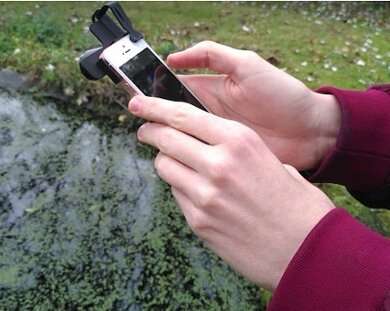Measuring water with your smartphone

You might take photos and selfies with your phone's camera, or scan a QR code. But there is much more you can do with it. Astronomer Olivier Burggraaff developed a phone attachment that allows you to take measurements of surface water with your smartphone.
Burggraaff is an astronomer doing a Ph.D. on measuring water with your smartphone. "Astronomers learn all kinds of things about the universe by analyzing light. But you can also use those same techniques to learn more about water on Earth," Olivier Burggraaff explains. "The camera in your smartphone is not very different from a professional instrument in a satellite. Smaller and less sensitive, but the technology works the same."
ESA and NASA use satellites to measure the composition of natural water on Earth, but cannot zoom in on details. "Of course, you can fly a drone with a camera over a lake, but that is very labor-intensive. It would be more convenient if many people could take measurements with their smartphones from time to time."
A phone attachment
The astronomer worked within the European MONOCLE project to improve detection techniques with smartphones. He also wanted to ensure that everyone can use them, regardless of the type of phone.
His research builds on the iSPEX project, which started in 2013. "Thousands of Dutch people took fine dust measurements in the air using a special attachment for their iPhone," says Burggraaff. "We wanted to revive this citizen science, or science by citizens, with an attachment for water measurements."
Burggraaff explains how it works: "The attachment projects a spectrum onto the phone's camera. In other words, the colors from the light are separated, just like a rainbow. That way, you can measure exactly how much light of each color—or wavelength—is present. We combine those data with the polarization, which is the direction in which the light waves vibrate. Together, that gives a lot of information about the light."
And therefore also about water. "Because if you know which wavelengths are reflected or absorbed by the water, you can deduce all kinds of things about what is in the water. Think of algae, dissolved organic material, or certain categories of chemical substances, but also particles in the water that originate from the soil or are precipitated from the air."
Hundreds of smartphone types
Burggraaff managed to greatly improve the quality of smartphone measurements with a number of adjustments. "For instance, we now no longer use JPGs but RAW files from the camera," he explains. "With that, you measure light intensity much more accurately."
Besides improving the measurement technology, he worked with partner Bright LED Solutions from Veldhoven on an attachment that fits almost all smartphones. "Or in fact, this company can now make an exactly fitting plate on demand for almost any type of smartphone—and there are hundreds of them. To do so, they use an automatically adjustable casting mold."
"More than with the original iSPEX, we want to put people in control," Burggraaff notes. "Back then, we did all the analyses ourselves, but with the new iSPEX 2, people can decide for themselves what to do with the results. For example, do you live by a river and notice changes in color or odor? Then you can measure what happens yourself. The app, developed by Heerlen-based partner DDQ, explains this."
How did the astronomer like being involved in such "earthly" research? "It took a while to get used to, but there is also a lot of overlap with astronomical research. I have colleagues looking for life on other planets; they also want to know how to detect life on Earth. There may even be an instrument on the moon to look at the Earth in the future. Suppose our planet were an exoplanet: could you find life?"
Burggraaff doesn't know yet which direction he will take after his Ph.D. "I really enjoyed doing this interdisciplinary research. There were many different aspects to it and I actually enjoyed all of them. So it is difficult to choose."
More information: While the prototype attachment for water measurements is ready, it is not yet commercially available. Those who are interested can sign up for the newsletter and updates at www.ispex.org.





















